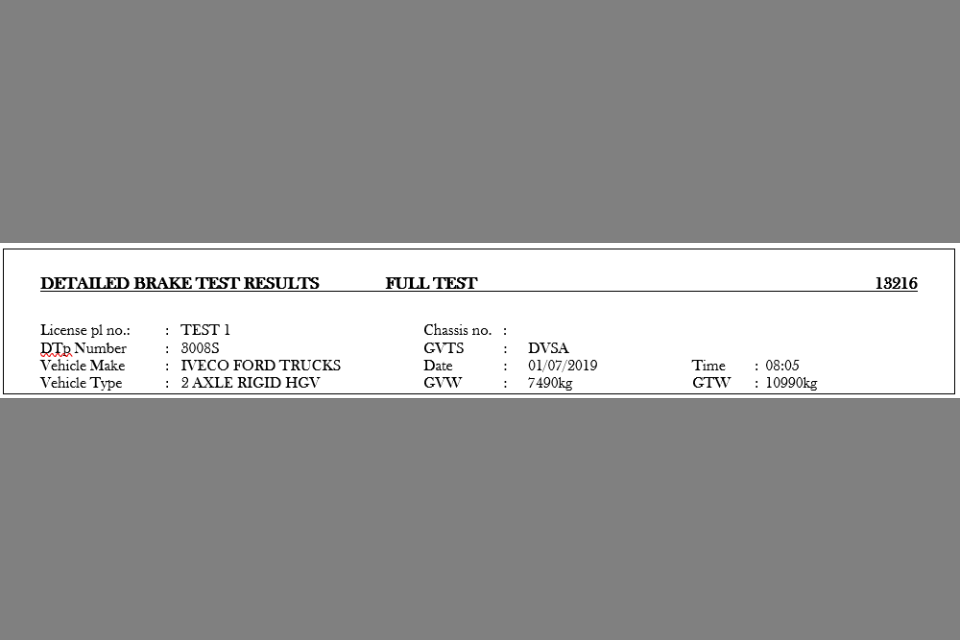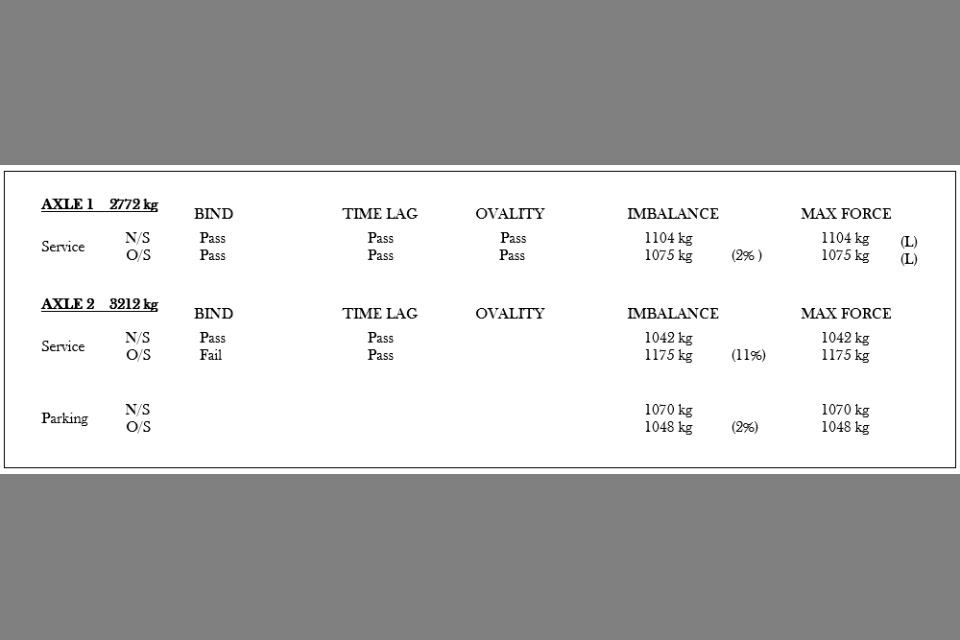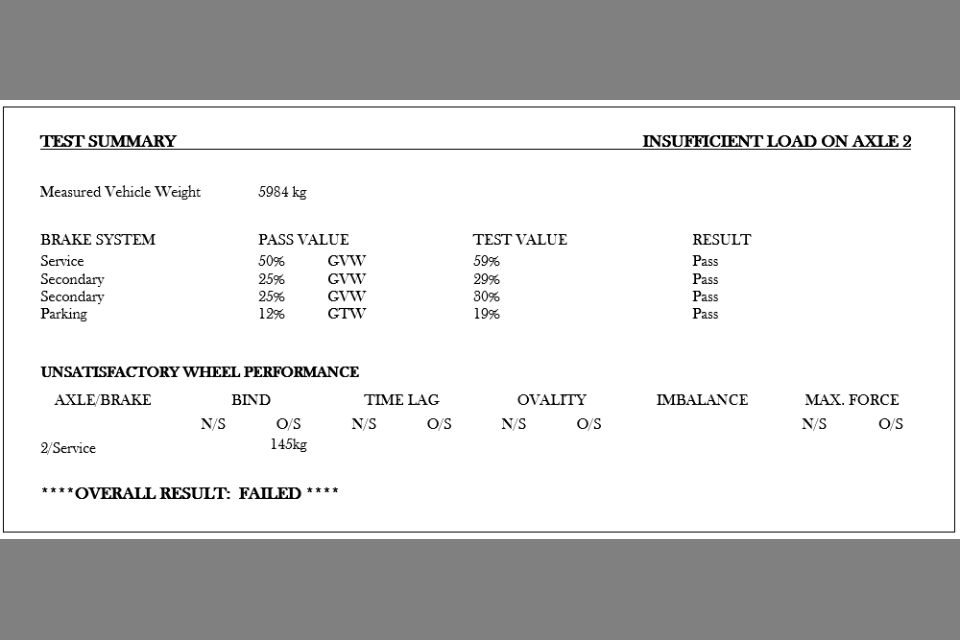Understanding your HGV or trailer’s brake test report
Published 10 February 2022
Applies to England, Scotland and Wales
You should get your HGV or trailer’s brakes tested by a roller brake tester (RBT) at least 4 times per year, including at the MOT.
Your vehicle must be loaded for a brake test - ideally to at least 65% of its total maximum weight. It can only be tested unladen if it cannot be loaded due to design limitations or the type of load it normally carries. Check what vehicles can be tested unladen.
The brake test report will tell you whether you passed or failed the test. It has 3 sections that include:
- details about the vehicle being tested
- information about the brake performance of each axle
- a summary of the test results for each brake system, showing how your brakes performed during the test (called brake efficiencies)
You should use this report to:
- make sure you brakes are in a safe condition
- identify any problems and carry out repairs
You should keep a printout of the brake test and attach it to your vehicle’s safety inspection record.
Section 1: information about your vehicle

The first section of the report contains information about your vehicle including:
- its registration details
- make and model
- the test centre
- maximum design weights
Depending on the type of vehicle or trailer, the design weight will be be displayed as either:
- gross vehicle weight (GVW) - for a fully loaded vehicle or trailer
- gross train weight (GTW) - for a fully loaded vehicle and trailer
- total axle weight (TAW) - for fully loaded trailer axles
The DTp number should match the one shown on the vehicle’s plating certificate. Your test result may be incorrect if it’s wrong.
Section 2: your vehicle’s brake performance results by axle

The report will show the axle weights and the results of checks on your vehicle’s brakes for:
The results are ordered by axle and will show the results for the near-side (N/S) and off-side (O/S) readings of the service brake and parking brake. They will also include readings for a secondary brake if your vehicle has an independent control brake system, but not if it’s a split system.
The table shows what is checked during the test and when it will fail.
| Check | When it will fail |
|---|---|
| Bind (service brake only) | more than 4% |
| Time lag | Manual assessment made |
| Ovality | 70% or higher |
| Imbalance (service and designated secondary brake only) | more than 30% |
| Max force | less than 5% |
If your vehicle fails any of these checks, the result will be shown under the ‘Unsatisfactory wheel performance’ header at the bottom of the report.
Designated secondary imbalance is not automatically assessed by the RBT and will be manually entered by an assessor.
Axle weight
The report will show the weight of each axle in kg. It must be at least 50% of the design axle weight displayed on the manufacturers plate and plating certificate.
You should aim for each axle to weigh at least 65% of the design axle weight. If any axle weighs less than 65%, an ‘insufficient load’ message will be included in the test summary. This does not include vehicle front axles.
Your wheels may have locked too quickly to give accurate results if your vehicle passed the test but the report included an ‘insufficient load’ message. You should get another brake test with a properly-loaded vehicle as soon as you can.
Bind
The bind reading checks to see if the brakes bind when the brake is not applied.
It is only displayed against the service brake performance.
The vehicle will fail if the brake bind is more than 4% of the measured axle weight.
The result will be shown as either a ‘Pass’ or ‘Fail’. If it’s a fail, the reading will be shown in kg under the ‘Unsatisfactory wheel performance’ heading.
Time lag
Time lag checks that there is not a delay between the brake being applied and it starting to work. It’s not measured by the roller test computer, so will always be shown as a pass on your report.
The assessor can override the result if they notice a significant lag during testing. They will let you know if your vehicle fails for this after the test.
Ovality
Ovality measures if there is any difference in the braking effort as each wheel rotates.
It’s only checked on HGV’s steered axles.
The vehicle will fail if there is a difference of more than 70% between the highest and lowest brake reading at a steady pedal pressure.
The result will be shown as either a ‘Pass’ or ‘Fail’. If it’s a fail, the reading will be shown as a percentage under the ‘Unsatisfactory wheel performance’ heading.
Imbalance
Imbalance across an axle is calculated using the maximum brake efforts at each wheel. These are shown in the results in kg, along with the imbalance across an axle as a percentage.
The vehicle will fail if the brake imbalance is more than 30%. However, this does not apply if both wheels lock, or if one wheel locks and the braking effort of the locked wheel is less than that of the other.
You cannot fail due to excessive parking brake imbalance, but the result will be included on your report.
If your vehicle passes the imbalance check but the imbalance is over 25% you should investigate why this is and look to adjust your brakes to lower the imbalance. Imbalanced brakes can cause the vehicle to pull to one side under heavy braking.
Max force
The report shows the maximum brake effort at each wheel in kg.
Your vehicle will fail if either:
- a wheel records no brake effort
- the maximum force is less than 5% of the measured axle weight
If your wheel locks during the check, the report will show the reading followed by an (L). You will pass the efficiency test if more than half the wheels of a braking system lock.
Section 3: test summary

The test summary shows how the vehicle or trailer has performed during the brake test.
It shows:
- the total measured weight of your vehicle in kg
- brake system - which brake systems were checked
- pass value - the brake efficiency percentage the brake system needed to pass the test
- test value - the brake efficiency percentage the brake system achieved during the test
- result - whether the brake system passed or failed the test
- Unsatisfactory wheel performance - only shown if your vehicle failed any of the earlier checks
- Overall result - whether your vehicle passed or failed the overall brake test
If the designated secondary brake is a split-system, two secondary brake efficiency results are shown, one for each half of the system. However, split-system secondary brake efficiency is no longer part of the MOT so you can ignore this.
If your test value says ‘FWA’
If any of your test value results have front wheel lock allowance ‘(FWA)’ after it, one or more of your front wheels locked during the test.
For trailers, front wheel lock allowance (FWA) only applies to one or two front steered axles on full drawbar trailers.
If a result says ‘Pass (Locks)’
If your report shows a result of ‘Pass (Locks)’, your vehicle will have passed because more than half of its wheels locked during the test. Although your vehicle passed, your wheels may have locked too quickly to give accurate results. If this was because your vehicle wasn’t loaded to at least 65% of its weight, you should get another brake test with a properly-loaded vehicle as soon as you can.
If a result says ‘Fail (alternative?)’
If your report shows a result of ‘Fail (alternative?) next to a designated secondary brake that is an independent control, it did not meet the efficiency requirement. The tester will check if the vehicle also has a split-system service brake. If each half of the split system meets the secondary efficiency required, then the vehicle can be passed for secondary using this alternative system.
You can ignore any ‘Fail (alternative)’ result for a designated secondary brake that is a split-system, as split-system secondary brake efficiency is no longer part of the MOT.
Understanding the brake test report for an unladen tri-axle semi-trailer
Due to the difficulty of loading a tri-axle semi-trailer for a brake test, it can be tested unladen.
To pass the test, the service and parking brake systems must achieve a specified level of brake force depending on the number of wheels that lock.
This test only applies to unladen tri-axle semi-trailers. It’s not used for any other type of unladen trailer.
Service brake performance
The table shows the minimum total brake force that the service brake must achieve depending on the number of wheels that lock during the test.
| Number of wheels locking | Minimum total brake force required |
|---|---|
| 6 | 3000kg |
| 5 | 3600kg |
| 4 | 4200kg |
| 3 or fewer | Normal laden trailer requirements apply |
Parking brake performance
The table shows the minimum total brake force that the parking brake must achieve depending on the number of wheels that lock during the test.
| Number of wheels locking | Minimum total brake force required |
|---|---|
| All wheels on which the parking brake operates lock | 1500kg |
| Any wheel on which the parking brake operates does not lock | 16% of design GVW |
